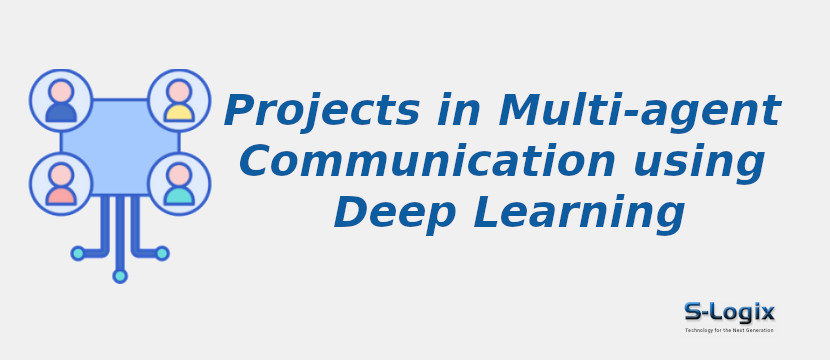Project Background:
The multi-agent communication using deep learning is rooted in the need to develop more effective and adaptive communication strategies among multiple autonomous agents. In traditional multi-agent systems, communication between agents often relies on predefined rules and hand-crafted protocols which can limit their flexibility in complex and dynamic environments. This offers a promising solution by utilizing deep neural networks to enable agents to learn and adapt their communication strategies from data. Researchers have explored various deep learning architectures, such as recurrent neural networks, deep reinforcement learning, and attention mechanism to facilitate communication and collaboration among agents. This approach has practical applications in diverse domains including robotics, autonomous systems, multi-agent games, and natural language dialogue systems. This project underscores the potential of deep learning techniques to enhance the coordination and cooperation of multiple intelligent agents in scenarios where effective communication is crucial.
Problem Statement
- This project work aims to address some problem by leveraging capabilities of deep learning techniques to autonomously learn and adapt communication strategies.
- The multi-agent systems exists a significant challenge in developing efficient, adaptive, and robust communication protocols that enable autonomous agents to effectively collaborate and coordinate their actions.
-
Traditional rule-based and hand-crafted communication methods are often limited in their ability to handle complex, dynamic, and diverse environments.
- The primary objective is to design, train, and evaluate models and architectures that can enhance the quality and efficiency of communication among multiple agents, across various domains including robotics, autonomous systems, and multi-agent games.
Aim and Objectives
- Enhance multi-agent communication for improved coordination and collaboration among autonomous agents.
- Develop deep learning models for agent-to-agent communication.
-
Design adaptive communication protocols that can evolve with changing conditions.
-
Enable decentralized and scalable communication strategies.
-
Address challenges related to partial observability.
-
Promote adaptability in dynamic and uncertain environments.
-
Apply research outcomes to practical multi-agent systems enhancing their efficiency and effectiveness.
Contributions to Multi-agent Communication
1. This project work contributes to the development of communication protocols that allow agents to make decentralized decisions while maintaining effective communication and reducing the need for centralized control.
2. The application of deep learning techniques enhances the ability of autonomous agents to coordinate and collaborate effectively that leading to better teamwork and problem-solving.
3. It enables the agents to adapt communication strategies based on real-time data, improving responsiveness to changing environmental conditions and requirements.
4. By improving the autonomy and communication abilities of agents, this work reduces the need for human intervention in the decision-making and control of multi-agent systems potentially saving time and resources.
5. This also contributes to the advancement of artificial intelligence and robotics by enabling more sophisticated and intelligent interactions between autonomous agents.
Deep Learning Algorithms for Multi-agent Communication
- Recurrent Neural Networks (RNNs)
-
Long Short-Term Memory (LSTM)
-
Gated Recurrent Unit (GRU)
-
Multi-Agent Reinforcement Learning (MARL)
-
Generative Adversarial Networks (GANs)
-
Variational Autoencoders (VAEs)
-
Proximal Policy Optimization (PPO)
-
Trust Region Policy Optimization (TRPO)
-
Graph Neural Networks (GNN)
-
Communication Networks
-
Memory Networks
Datasets for Multi-agent Communication
- Multi-Agent Behavior Dataset (MABD)
- Dialog Self-Play (DSP) dataset
- Multi-Agent Particle Environment (MAPE)
- Cooperative AI Benchmark (CoBench)
- StarCraft II Learning Environment (SC2LE)
- Multi-Agent Traffic Simulation (MATSim)
- Multi-Agent Action-Dialogue (MAAD) dataset
-
Dialog-based Multi-Agent Language Game (D-MALG) dataset
-
Multi-Agent World Simulator (MAWS)
Performance Metrics
- Message Efficiency
-
Communication Cost
-
Team Cooperation Rate
-
Information Transfer Rate
-
Mutual Information
-
Mean Opinion Score (MOS) for human interaction tasks
-
Communication Bandwidth Utilization
-
Resource Utilization
Software Tools and Technologies
Operating System: Ubuntu 18.04 LTS 64bit / Windows 10
Development Tools: Anaconda3, Spyder 5.0, Jupyter Notebook
Language Version: Python 3.9
Python Libraries:
1.Python ML Libraries:
- Scikit-Learn
- Numpy
- Pandas
- Matplotlib
- Seaborn
- Docker
- MLflow
2.Deep Learning Frameworks:
- Keras
- TensorFlow
- PyTorch
